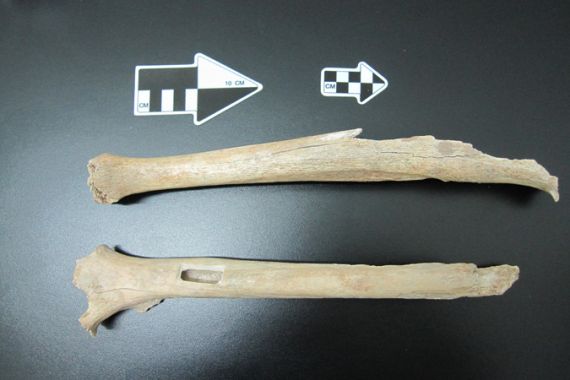New genetic clues from China’s ancient man
Remains of 40,000-year-old Homo sapien help scientists map first human migration routes out of Africa.

Beijing, China – Genetic evidence linking early people in China with Native Americans has been unearthed in a cave with important implications for our understanding of how humanity spread across the globe.
DNA from an early human who lived 40,000 years ago found at Tianyuan Cave just outside Beijing also reveals the man had genes from the now-extinct Neanderthal.
The discovery of the fisher-gatherer – one of the earliest Homo sapiens ever uncovered in China – is providing new clues about the routes our species took as it migrated from Africa.
Qiaomei Fu, one of the scientists who studied the remains at Germany’s Max Planck Institute for Evolutionary Anthropology, said the DNA indicated the caveman was genetically related to today’s Amerindians.
“The Tianyuan individual derived from a population that was ancestral to many present-day Asians and Native Americans,” Fu and her colleagues wrote in a scientific journal.
Fu said it is possible the descendants of the Tianyuan were the first humans to cross the intercontinental Bering land bridge to populate the Americas when glaciers began to recede during the last Ice Age.
The Tianyuan find provides a dramatic new piece in the jigsaw puzzle that paleoanthropologists have been putting together for decades in a bid to map the evolution of our species.
 |
| The Tianyuan Cave just outside Beijing [Qiaomei Fui/Al Jazeera] |
Fu is part of an international team that matched the DNA against people now living in Africa, Europe and Asia, which worked alongside Beijing’s Institute of Vertebrate Paleontology and Paleoanthropology (IVPP).
The scientists believe the discovery could suggest that the Tianyuan humans were the ancestors of populations now found across East Asia and the Americas.
The discovery a century ago of 500,000-year-old skulls of the species Homo erectus in a cavern outside Beijing had led some archaeologists to argue that China was the crucible of modern humans. But later excavations suggested Homo sapiens arose in Africa then expanded outwards.
DNA mapping
For decades, paleoanthropologists relied on clues provided by the anatomy of early humans and their stone tools to piece together how Homo sapiens spread, but genetic information has transformed this effort.
Chris Stringer, research leader in human origins at the Natural History Museum in London, told Al Jazeera that early modern humans displayed a strong urge to explore.
By 45,000 years ago, they were migrating along the coasts of Asia, and had built boats to navigate the waters of the Red Sea, the Arabian Sea, and beyond.
“As for the dispersion across or around mainland Asia, I think an initial coastal dispersion was most likely, followed by movement inland along river courses,” he explained.
By at least 42,000 years ago, Homo sapiens had also begun to colonise Australia – although this could have been accidental, Stringer said.
It is likely early humans began settling along the southern and eastern coasts of China at the same time, trekking along the shore or using small boats, said Haowen Tong, an IVPP professor who led the initial excavation of Tianyuan Cave.
A dramatic insight provided by the cave find is that these early humans also had genes from Neanderthals – cousins of Homo sapiens found in Europe and Asia during the Ice Age.
|
|
| Fossil uncovers pre-historic sea monster |
Fu and other scientists compared the DNA of the Tianyuan human with that of the Neanderthal that the Max Planck Institute helped sequence in 2010.
All humans outside of Africa carry genes that match Neanderthal DNA of up to 4 percent, suggesting interbreeding between the species – but no evidence has been found of Neanderthals in Africa. Fu said the Tianyuan remains displayed a similar mix.
She added: “The Neanderthal genetic component in the [Tianyuan] early modern human was likely due to interbreeding after early modern humans had left Africa and overlapped with Neanderthals in the Middle East, before splitting into separate groups heading towards what are now Europe and East Asia.”
Mixing with Neanderthals
Paleoanthropologist Erik Trinkaus of Washington University in Missouri, who led an earlier Tianyuan study, said the find helped prove that, as they began expanding beyond Africa, “modern humans spread and mixed with regional groups of archaic humans – what we call Neanderthals”.
The two species also may also have intermixed culturally when their populations overlapped. Like Homo sapiens, Neanderthals transformed beach shells into decorative beads, painted them, and engaged in symbolic behaviour, said Trinkaus.
According to researchers at the Max Planck Institute for Psycholinguistics in the Netherlands, it is likely that millennia of encounters in the Middle East meant the languages of the two species also merged.
Scholars Dan Dediu and Stephen Levinson argued in a recent study that there is “a broad range of evidence from linguistics, genetics, paleontology, and archaeology clearly suggesting that Neanderthals shared with us something like modern speech and language”.
And early modern humans might have retained traces from these exchanges as they expanded across Asia, and then the Americas.
Dediu told Al Jazeera it is even possible remnants of Neanderthal speech have survived into modern languages.
However, it remains unclear whether the two species cooperated as they spread out across western Eurasia – or competed for territory and natural resources.
IVPP director Zhonghe Zhou said the institute is now creating a joint laboratory with the Max Planck Institute to sequence any genetic information recovered from ancient humans.
“A Nature report last week on the sequencing of a complete horse genome from a bone dating to around 700,000 years ago seems to have significantly extended the known limit of DNA retrieval, thanks to new technology and exceptional preservation,” Zhonghe said. “This provides the prospect of conducting DNA studies on more ancient fossils.”